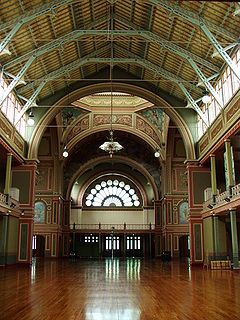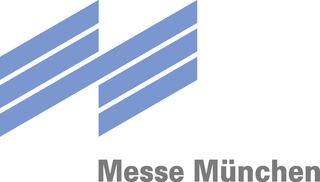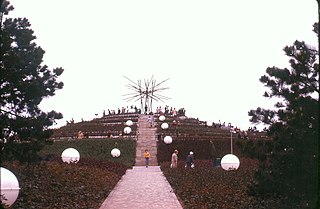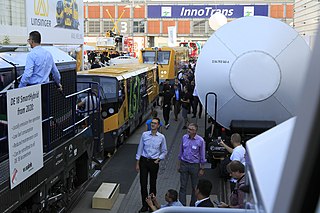
A world's fair or world fair is a large international exhibition designed to showcase achievements of nations. These exhibitions vary in character and are held in different parts of the world at a specific site for a period of time, ranging usually from three to six months.

The Deutsches Museum in Munich, Germany, is the world's largest museum of science and technology, with about 28,000 exhibited objects from 50 fields of science and technology. It receives about 1.5 million visitors per year.

The Haus der Kunst is a non-collecting modern and contemporary art museum in Munich, Germany. It is located at Prinzregentenstraße 1 at the southern edge of the Englischer Garten, Munich's largest park.

The Melbourne International Exhibition is the eighth World's fair officially recognised by the Bureau International des Expositions (BIE) and the first official World's Fair in the Southern Hemisphere.

A garden / flora festival or exposition is a festival and exposition held to celebrate the arts of gardening, garden design, landscaping and landscape architecture. There are local garden festivals, regional garden festivals, National Garden Festivals and International Garden Festivals. The idea probably originated with Germany's Bundesgartenschau. The UK held five garden festivals in the period 1984–1992 but blundered through not planning an after-use for the festival grounds during their design and planning phase.
The Exposition internationale de la technique de l'eau de 1939 was the third specialized exposition recognized by the Bureau International des Expositions. In 1936 Georges Truffaut proposed an exposition to celebrate the completion of the Albert Canal. The exposition's theme was water management and opened on 20 May 1939 by King Leopold III of Belgium. The canal itself was opened on 30 July 1939.

Floriade 1992 was an international garden exhibition held in Zoetermeer, Netherlands, recognized by the Bureau International des Expositions (BIE) and organized under the authority of the Dutch Ministry of Agriculture and Fisheries. The Floriade ran from April 9 to October 10, 1992, and was held on a converted pasture outside Zoetermeer near The Hague. The exhibition covered 168 acres and had participants from more than 20 countries. Thirteen foreign countries participated. The Floriade hosted 3.36 million visitors.

The Floralies Internationales de Montréal was the 8th international horticultural exposition recognized by the Bureau of International Expositions. The Expo was split in two sequential exhibitions, starting with an indoor event in the former Olympic Velodrome and later on different gardens on Notre Dame Island, the site of the Expo 67. 17 countries were represented at the indoor exhibition and the Velodrome was converted to Montreal Biodome afterwards. The indoor exhibition opened on May 17 and closed May 29. The gardens at the outdoor part opened on May 31. 12 countries showed their gardens to the public during the summer until September 1.

Messe München GmbH is the operator of the Neue Messe München exhibition center, the ICM Internationales Congress Center München and the MOC Veranstaltungscenter München. The exhibition space of the 16 halls together is 180,000 m2 and another 425,000 m2 of outdoor area, making Messe München by far the holder of the largest outdoor area of all exhibition companies in Germany. Messe München organizes some 40 trade fairs for capital and consumer goods and key high-tech-industries in Munich and abroad.

The convention center ICM–Internationales Congress Center München belongs to Messe München. It is structurally integrated into the exhibition center in Munich's Messestadt Riem and has been operating since 1998 together with Messe München. International medical and scientific congresses, general meetings of listed companies as well as events take place in the ICM. Since 2011, the ICM operates together with Messe München and the MOC Veranstaltungscenter München as the Messe München Locations.
Highlights – Internationale Kunstmesse München is an exhibition of art and antiques in a wide range from ancient to modern. The art fair dates back to the "Deutsche Kunst und Antiquitätenmesse" initiated by Otto Bernheimer in 1956. The event, located in the Munich Haus der Kunst, is held annually in the fall and runs for 10 days. The current initiators of the exhibition are 19 art dealers who have established themselves at The European Fine Art Fair (TEFAF) in Maastricht, Netherlands, over the last two decades.
International Garden Expo 83 was a garden festival containing 170 exhibition contributors. The international horticultural exposition was recognised by the Bureau International des Expositions (BIE) and held from April 28 to October 9, 1983, at Westpark in Munich, Germany. Ralph Siegel wrote the Flower Serenade as official song of the exhibition; it was recorded by Hugo Strasser and his orchestra. The German Federal Post Office issued a special stamp with a stylized flower.
The International Gartenbauausstellung 73 was a garden festival held in Hamburg, Germany, which was recognized by the Bureau International des Expositions. The exposition was the 6th edition of the international horticultural exposition organised under the auspices of the Association of International Horticultural Producers (AIPH) and the second held at Planten un Blomen park in Hamburg. The exhibition took place on the same site where IGA 63 was held a decade earlier. There were some changes to the site location, such as the vaulting of the Marseillerstrasse so that visitors throughout the area without crossing could visit. Instead of a cable car, a park trail was constructed on the site to provide for visitors. The line had four stations and took 30 minutes to complete a lap.

The Wiener Internationale Gartenschau 74, often shortened to WIG 74, was a garden festival held in Vienna, Austria. Recognised by the Bureau International des Expositions, the Expo was the second international horticultural exposition to be held in Vienna under the auspices of the AIPH. The plans for the Expo began to develop shortly after the closing of the WIG 64 held a decade earlier. Following the success of the 1964 exposition, the council was urged to re-organize a horticultural exhibition. An area on the south side of town that had once served as a recording field for silent films was ideally suited to create a large park. In 1969, architect Erich Hanke won an international design competition. He then formed several working groups of landscape architects from various countries, who made different designs for parts of the site. The best designs were incorporated into the grounds. A monorail was built to transport the visitors, but was eventually scrapped due to lack of success.
Deutsche Internationale Schule Changchun (长春市德国国际学校) is a German international school in Changchun, Jilin, China. It serves years 1-10.
The Exposition Internationale de l’habitation et de l’urbanisme was a specialised exhibition recognised by the Bureau International des Expositions (BIE), which held in the French capital Paris between July 10 and August 15 in 1947. It focused on housing estate projects in the context of post-war reconstruction and attracted 14 participating countries including Mexico, Poland and South Africa.
The International Textile Exhibition of 1951 was held at the ‘Grand Palais de la Foire de Lille’ in Lille, France.















